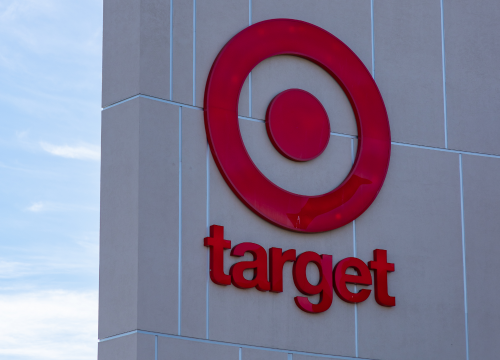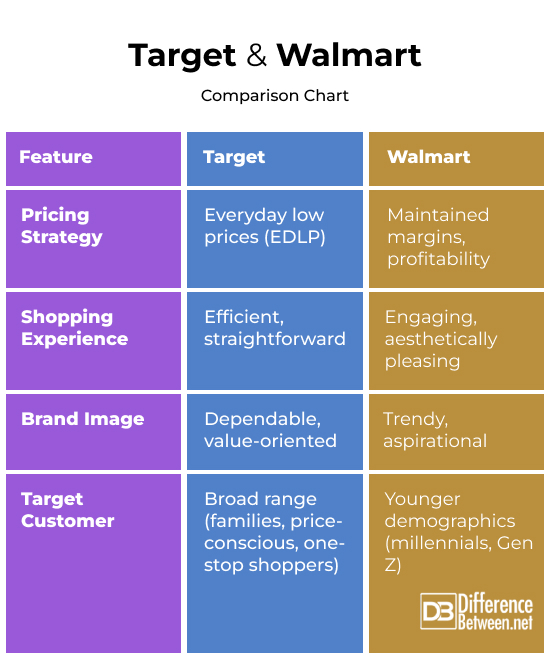Difference Between Target and Walmart
Only a few brand rivalries have managed to capture the attention of consumers and industry observers quite like the ongoing saga of Target vs. Walmart. The clash between Target and Walmart extends beyond mere business competition. It reflects the dynamic nature of the retail industry and the ever-evolving preferences of the diverse consumer base. In this article, we’ll talk about these retail giants in detail and highlight some key differences between Target and Walmart.

Target
Target is one of America’s leading retailers and operates a chain of department stores and hypermarkets in all fifty states. The company was founded in 1902 as the Dayton Dry Goods Company by George D. Dayton. Over the years, it underwent a transformation and rebranding in 1962 to become Target Corporation. The company adopted a unique approach, offering a mix of quality, style, and affordability—a concept that set it apart in the retail space.

Walmart
Walmart is the world’s largest retail company, operating over 10,500 stores in 24 countries and employing over 2.3 million people. It is a multinational retail corporation and one of the world’s largest and most influential companies in the retail industry. Imagine a small-town five-and-dime store in the 1940s, overflowing with everyday household items at unbelievable prices. That’s where the Walmart story begins, with Sam Walton’s vision of offering “everyday low prices” to his customers.
Difference between Target and Walmart
Business Model
While both Walmart and Target are big-box discount retailers, they have different business models. Target focuses on maintained margins over the lowest price. They prioritize higher profit margins on their private-label brands and fashion items, while offering competitive prices. Walmart, on the other hand, prioritizes everyday low prices and aims for the absolute lowest price on most products. Walmart is at least five times larger than Target.
Product Selection
Target features a curated selection with an emphasis on trendier and more design-forward products, particularly in home goods and apparel. They target a younger, style-conscious demographic. Walmart, on the other hand, offers a vast selection of products, encompassing groceries, general merchandise, electronics, and more. They cater to a broad range of customers seeking one-stop shopping convenience.
Shopping Experience
Target Creates a more engaging and aesthetically pleasing shopping environment. Stores are designed to be visually appealing, and customer service is considered a priority. The in-store shopping experience surpasses the standard Walmart shopping experience by a significant margin. Target sets itself apart with spacious aisles, neatly organized shelves, a retail atmosphere akin to department stores, and stylish design elements. Walmart emphasizes efficiency and speed in its stores.
Private Label Brands
Target places a greater emphasis on its own brands, such as Threshold and Archer Farms, often collaborating with designers and focusing on unique product designs. It targets a younger demographic, millennials and Gen Z, with disposable income and an interest in design and trends. Walmart focuses on its private-label brands, such as Great Value and Equate, offering comparable quality at significantly lower prices. It targets a broad range of customers, including families and price-conscious shoppers.
Target vs. Walmart: Comparison Chart

Summary
Ultimately, the best choice for a shopper depends on their individual needs and priorities. If price is the primary concern, Walmart is likely the better option. However, if shoppers value style, design, and a more curated selection, Target may be a better fit. Target projects a trendy and aspirational brand identity, while Walmart cultivates a dependable and value-oriented image.
FAQs
How does Target differ from Walmart?
Walmart focuses on Everyday Low Prices (EDLP), while Target prioritizes profit margins and a youthful image. Walmart generally offers lower prices than Target, especially on national brands. However, Target’s private-label brands are often competitive and offer unique designs.
What is the difference between Walmart customers and Target customers?
Walmart customers prioritize value and convenience, often seeking the lowest prices on essential items. Target customers are more style-conscious and willing to pay slightly more for unique and trendy products.
Which company is doing better, Walmart or Target?
Currently, Walmart is outperforming Target in terms of revenue and market share. However, Target has experienced consistent growth and profitability in recent years, focusing on a differentiated brand strategy and online shopping experience.
Why do people like Target more than Walmart?
People might prefer Target for the following reasons:
- Trendy and aesthetically pleasing stores
- Higher quality and unique private-label brands
- More engaging shopping experience
- Focus on customer service
- Targeted marketing towards younger demographics
What separates Target from Walmart?
Target’s focus on design, curated product selection, and an engaging shopping experience differentiates it from Walmart’s emphasis on low prices and a vast selection.
What is a weakness of Target compared to Walmart?
One of Target’s weaknesses compared to Walmart is its slightly higher prices on general merchandise. This can be a deterrent for some price-conscious shoppers.
Is Target more ethical than Walmart?
This is a complex question with no easy answer. Both companies have faced criticism for their labor practices and environmental impact. However, Target has taken some steps to improve its ethical standing, such as sourcing products from sustainable sources and promoting diversity and inclusion in its workforce.
What are Target’s weaknesses?
Target has a smaller footprint and product variety compared to Walmart. It also has higher prices on some items compared to Walmart.
What problems does Target face?
- Competition from other retailers, both online and offline.
- Rising costs of goods and labor.
Why do people choose Target?
People choose Target for various reasons, including:
- Trendy and stylish products.
- Engaging shopping experience.
- Strong customer service.
- Private-label brands with unique designs and good quality.
Why is Walmart outperforming Target?
Walmart has a wider variety of products at lower prices, a larger footprint, and a broader geographic reach. Additionally, Walmart focuses on essential items and groceries, which are less affected by economic downturns.
Why is Target so unique?
Target distinguishes itself from competitors through:
- Strong brand identity.
- Focus on design and curated product selection.
- Engaging and aesthetically pleasing shopping experience.
- Emphasis on social responsibility and ethical sourcing.
- Difference Between Caucus and Primary - June 18, 2024
- Difference Between PPO and POS - May 30, 2024
- Difference Between RFID and NFC - May 28, 2024
Search DifferenceBetween.net :
Leave a Response
References :
[0]Chastain, Bill. Chastain, Bill. The Target Story: How the Iconic Big Box Store Hit the Bullseye and Created an Addictive Retail Experience. HarperCollins Leadership, 2020.
[1]Reuter, Dominick. “Walmart and Target Are Looking Increasingly Similar These Days.” Business Insider, 4 Dec. 2023, www.businessinsider.com/walmart-and-target-are-looking-increasingly-similar-these-days-2023-12?IR=T.
[2]Mirzayev, Elvin. “Walmart vs. Target Business Model: What's the Difference?” Investopedia, 3 Sept. 2019, www.investopedia.com/articles/active-trading/070715/target-vs-walmart-whos-winning-big-box-war.asp.
[3]Gruber, Bryce. “Target vs. Walmart: Which Is Best?” Reader’s Digest, 17 Aug. 2023, www.rd.com/article/target-vs-walmart/.
[4]Image credit: https://www.canva.com/photos/MAEYFv9yWCU-empty-shelves-in-the-supermarket-due-to-covid19-panic-buying/
[5]Image credit: https://www.canva.com/photos/MAFarxtRt9Y-target-retail-chain-and-supermarket/
